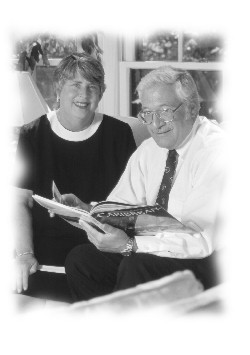
Julie Damon, and her husband, Bill, now work to promote organ donation awareness. (photo by Anne Rayner)
Since it was founded 10 years ago, the Vanderbilt Transplant Center has become recognized as one of the nation's premier centers in transplantation.
Its multi-disciplinary alliance of transplant specialists share a common interest in the efficient acute and long-term care of patients through advances in immunosuppression, organ and tissue procurement, avoidance of complications and facilitation of social support.
Formed in 1989 as an organized, full-service center in transplantation, the Vanderbilt Transplant Center makes its home on two adjacent floors of the Oxford House. This configuration promotes collaboration on clinical and research issues among physicians, nurses and staff members.
The center boasts extensive clinical experience in each of its established transplant programs, excellent clinical outcomes and experienced leadership. All the programs are Medicare approved and each has survival figures that surpass the national averages.
Enhanced patient care and a better quality of life are provided to all transplant patients through the unique patient support services offered by Transplant Psychiatry, Ethics, Infectious Disease, Social Work and the Return-To-Work Program.
Each of these efforts is an integral part of the Transplant Center and part of a shared infrastructure designed to provide cost-effective, consolidated, common transplant services to deliver effective and efficient patient care.
Here is a brief look at the primary programs of the Vanderbilt Transplant Center:
Kidney
Dr. Robert E. Richie, surgical director
Dr. J. Harold Helderman, medical director
When Began: 1962
Numbers Performed: more than 2,500
Success Rates: 98 percent vs. UNOS at 95 percent
Number on Waiting List: 200
One of the largest programs in the United States. The patient one-year survival rate is 96.4 percent and a graft survival is 88.7 percent (significantly better than those by UNOS). Significant features of the program include the extension of surgical support to Vanderbilt patients at Saint Thomas Health Services in 1997. The kidney/pancreas transplant program was one of the nation's first.
Heart
Dr. Davis Drinkwater, surgical director
Dr. Stacy Davis, medical director
When Began: 1985
Numbers Performed: in 98 – 22; total 326 not including heart/lung
Success Rates: 89 percent vs. UNOS at 82 percent
Number on Waiting List: 24
Vanderbilt's pioneering advances in heart transplantation is the reason why it is known as the region's premier heart transplant center. VU also performed the state's first pediatric heart transplant as well as the first transplant in infants for hypoplastic left heart syndrome. It is the largest program in the midstate. Its survival rates exceed the national average — one-year is 89 percent while three-year is 81 percent and five-year is 74 percent. It is the only center in state performing transplants in children under one year of age.
Lung
Dr. Richard N. Pierson III, surgical director
Dr. James Loyd, medical director
When Began: first heart-lung in 1987; first single-lung in 1990; double lung in 1994
Numbers Performed: in 98 – 17
Success Rates: 80 percent vs. UNOS at 70 percent
Number on Waiting List: 12
The lung transport team anticipates adding living donor lung transplants to the list of surgical options for end-stage lung disease. Many research efforts are underway including studying the hyperacute rejection of pig lungs by human blood with a long-term goal of using pig lungs as an alternative to cadaver lungs. One and three-year survival rates are about 80 percent and 65 percent respectively (well above the national average of 70 percent and 50 percent). The Heart/Lung program was established in 1985.
Bone Marrow
Dr. Friedriech Schuening, adult BMT director
Dr. Haydar Frangoul, pediatric BMT director
When Began: 1983
Numbers Performed: in 98 – 156
Vanderbilt was the third medical center in the nation selected to provide bone marrow transplants for VA Hospital patients.
Liver
C.Wright Pinson, director
When Began: 1991
Numbers Performed: in 98 – 48; total 234
Success Rates: 86 percent vs. UNOS at 81
Number on Waiting List: 68
Liver Transplant program began in 1991. Survival rates of 86 percent for one year and 82 percent for two to five years. In 1995 Vanderbilt signed a $5.3 million contract to perform transplants at the VA. Eighty-five percent of liver transplant patients return to work.
Pancreas
William Nylander, director
When Began: 1985
Vanderbilt began its program in 1985 and pioneered the use of the color flow Doppler ultrasound to detect pancreas rejection. Pancreas transplantation is an extension of kidney transplant and diabetes research. There is a 90 percent survival rate and 75 percent graft one-year survival since 1990.













